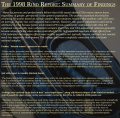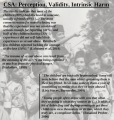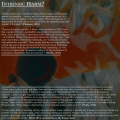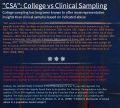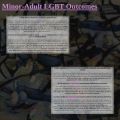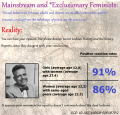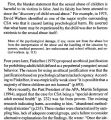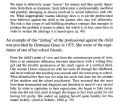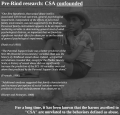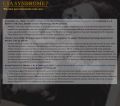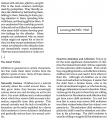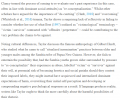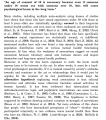- Web Archive (within series)
Our page on family environment demonstrates that any relationship between adult-minor sex and harm is unlikely to be causative. Our section on outcomes and poly-victimization shows that the purported relationship is unlikely to exist in the first place, when all legally-defined "abusive" interactions (rather than just forceful/unwanted) are accounted for.
A mental exercise you can perform to better understand how lesser (clinical sample, coercive sample) studies associate CSA with later psychological sequelae:
- Forceful or unwanted sexual contact with a minor is deemed highly unacceptable throughout the western world.
- Forceful or unwanted sexual contact is therefore deemed an extraordinary and highly taboo behavior throughout the western world.
- Extraordinary and highly taboo, coercive behaviors are generally only perpetrated against extraordinary individuals, under extraordinary circumstances...
- One such circumstance, is to ever be subjected to a forced sexual contact, the minor is far more likely to have been seen as vulnerable, or to come from a vulnerable background.
- Vulnerable individuals from backgrounds that make them vulnerable are far more likely to suffer from mental disturbances and drug dependency problems, for example.
- Another such circumstance, is that the perpetrator of the assault is likely to be mentally disturbed, and may already be in an abusive relationship with the victim.
- Given the above, is it likely to be a single (or even multiple) "sexual" contact/s that caused the later impairment, or instead, pre-existing characteristics, general life trajectory, abusive relationships and other factors such as self-perception?
The 9 criteria outlined by Austin Bradford Hill in The Environment and Disease: Association or Causation? are used to determine whether causation can be assumed in medicine. This page will review the research on adult-minor sex to see if these criteria have been met. Unfortunately, much research fails to disentangle voluntary adult-minor/child sex from clearly abusive activity, so our papers examine the construct of 'child sexual abuse' as arbitrarily defined, for instance by law:
- Biological gradient: the demonstration of a biological gradient, in which more of the causative agent leads to a poorer outcome.
- Forouzan, Elham, and Gijseghem, Hubert Van (2005). "Psychosocial Adjustment and Psychopathology of Men Sexually Abused During Childhood," International Journal of Offender Therapy and Comparative Criminology, 49(6), 626-651
- "Certain studies conducted with clinical participants have revealed that frequency and duration of sexual contacts had a significant effect on the development of the participant (Freeman-Longo, 1986; Friedrich, Urquiza, & Beilke, 1986; Gerber, 1990; Mendel, 1995), whereas studies carried out with nonclinical participants reported no clear link between frequency and duration of contacts and the development or later aggravation of disorders of whatever nature among participants (Finkelhor, 1979; O’Neill, 1990; Sarbo, 1984; Urquiza & Capra, 1990)."
- Rind, B., Tromovitch, P. & Bauserman, R. (1998). "A meta-analytic examination of assumed properties of child sexual abuse (CSA) using college samples," Psychological Bulletin, 124(1), 22-53
- "Multiple regression analyses showed that the intensity of the relationship between CSA and adjustment varied reliably as a function of gender, level of consent, and the interaction of these two factors. It is noteworthy that neither the level of contact nor the interaction between gender and level of contact was related to intensity. These latter results failed to provide support for the common belief that contact sex is more harmful than noncontact sex or that contact sex for girls is especially harmful. These conclusions, however, should be viewed cautiously because of the overlapping nature of the two levels of the contact variable (i.e., contact only versus contact and noncontact sex). This same caveat applies to consent because its two levels (unwanted versus willing and unwanted) were overlapping as well. [...] In separate moderator analyses, we examined how aspects of the CSA experience moderated self-reported reactions and effects, as well as symptoms. Although these results should be viewed cautiously because they were usually based on a small number of samples, we found that only force and incest moderated outcomes. The largest relation occurred between force and self-reported reactions or effects, but force was unrelated to symptoms. Incest moderated both symptoms and self-reported reactions and effects. Penetration, duration, and frequency did not moderate outcomes. The near-zero correlation between penetration and outcome is consistent with the multiple regression analysis finding that contact sex did not moderate adjustment. [...] This finding is consistent with Laumann et al.'s (1994) failure to find an association between their composite variable (consisting of penetration, number of older partners-abusers, relatedness of partner-abuser, frequency of contacts, age when having contacts, duration of contacts) and adjustment for SA respondents in their study of a U.S. national sample. "
- Finkelhor, D. (1979). Sexually victimized children. New York: Free Press.
- "Unlike force, sexual activity and duration both are ambiguous in their implications. A longer relationship and one involving intercourse indicate greater intensity. Intensity may be more harmful, but it could also be an indicator in some cases of a positive, or at least. an ambivalent, bond. In contrast, presence of force would almost always signal something negative about the relationship. It is a concise symptom of a whole negative context - the reluctance of the child, the pressure exerted by the partner, the difference in power and control. The primary recollection of the child is of the coercion. That there was sex involved is perhaps less important than the fact that there was aggression." (pp. 104-105; as cited in Rind, 2001)
- Consistency: consistency of the findings across research sites and methodologies.
- Bauserman, Robert, and Rind, Bruce (1997). "Psychological Correlates of Male Child and Adolescent Sexual Experiences with Adults: A Review of the Nonclinical Literature," Archives of Sexual Behavior, 26(2), 105-141.
- "Clearly, by whatever measures of effects are used, the nonclinical research findings reviewed here differ consistently from clinically based studies of the correlates of early sexual experiences."
- Forouzan, Elham, and Gijseghem, Hubert Van (2005). "Psychosocial Adjustment and Psychopathology of Men Sexually Abused During Childhood," International Journal of Offender Therapy and Comparative Criminology, 49(6), 626-651
- "Certain studies conducted with clinical participants have revealed that frequency and duration of sexual contacts had a significant effect on the development of the participant (Freeman-Longo, 1986; Friedrich, Urquiza, & Beilke, 1986; Gerber, 1990; Mendel, 1995), whereas studies carried out with nonclinical participants reported no clear link between frequency and duration of contacts and the development or later aggravation of disorders of whatever nature among participants (Finkelhor, 1979; O’Neill, 1990; Sarbo, 1984; Urquiza & Capra, 1990)."
- Temporality: the demonstration of the appropriate temporal sequence, so that the causative agent occurs prior to the outcome.
- Rind, B., Tromovitch, P., & Bauserman, R. (2001). "The validity and appropriateness of methods, analyses, and conclusions in Rind et al. (1998): A rebuttal of victimological critique from Ondersma et al. (2001) and Dallam et al. (2001)," Psychological Bulletin, 127, 734-758.
- "Finkelhor et al.'s (1990) national sample findings are also relevant to this issue. They conducted a series of analyses that indicated that "unhappy family life is a true risk factor [for CSA] and not simply a distorted perception that a victim develops as a result of having been abused" (p. 24)."
- Strength: the demonstration of a strong association between the causative agent and the outcome.
- Specificity: the demonstration of specificity of the causative agent in terms of the outcomes it produces.
- Plausibility: the demonstration of a biologic rationale, such that it makes sense that the causative agent causes the outcome.
- The most popular proposed mechanism for the relationship between adult-child sex and its supposed non-sexual symptoms cannot reasonably be applied to fully consensual activity in the context of an accepting society. See "The traumatic impact of child sexual abuse: A conceptualization" in Research: Secondary Harm
- Analogy: evidence from analogous conditions.
- Minor peer sexual activity is (when defined correctly) analogous to adult-minor sexual activity. The results are similar (impairment can be found, sometimes before elimination of confounds, sometimes when forceful contact is insisted upon), but only in a way that appears to demonstrate the absence of a relationship, let alone causation. See the studies on mental health at Research: Youth sexuality.
- Coherence: coherence of the findings, such that the causation argument is in agreement with what we already know.
- Experimental evidence.
- As demonstrated throughout this project, as studies improve in quality and become more exacting, the purported association between CSA and later psychological impairment fades to insignificance.
Excerpt Graphic Library
The EGL on Harm has some relevant information. Just right click/save and reproduce by uploading in short-form media to bypass character limits.
-
Basic Rind Paradox infographic
-
Summarized Rind findings
-
Rind and Tromovitch (2000) on Iatrogenic Harm
-
Research pointing to no intrinsic harm profiled in The Guardian
-
What victimologists say about youth perception + admissions of iatrogenic harm
-
Self-perception: Importance
-
Some reading on secondary harm and perception/situational variables
-
More secondary harms
-
Intrinsic vs secondary harm
-
Daly's 2021 repetition of Rind (1998), finds that self-perception is far more important that abuse status
-
Lahtinen Report: Most common reason for not reporting - event not serious enough
-
-
Bender. Sexologist's observations in 1969
-
College outcomes: Benefits of college samples
-
-
Arreola 2009 - Psych outcomes for LGBT "CSA" identical to no sex
-
Simpler way of expressing Lesbian outcomes (ref to modern feminism)
-
Further distillation of Rind's Kinsey analysis
-
-
Finer analysis of Finnish Victimization Survey (Rind)
-
General reading on intrinsic harm
-
Oellerich on the self-fulfilling prophecy of iatrogenic harm
-
Oellerich comments further on iatrogenic harm
-
CSA harm was known to be confounded even before Rind
-
No "typical" CSA reaction or "syndrome"
-
Rind on methodological issues/limitations of victimology
-
The Lanning (1992) report - full of hysterical conjecture, nevertheless describes the "most common" forms of offender and victim in banal terms that are applicable to most relationships (in order to prepare investigators to pathologize banality)
-
Percy Foundation review of Chloe Taylor: "Foucault, Feminism, & Sex Crimes"
-
2022 debate response
-
Illinois state investigation finds a "pedophile" was his victims' "best friend"


